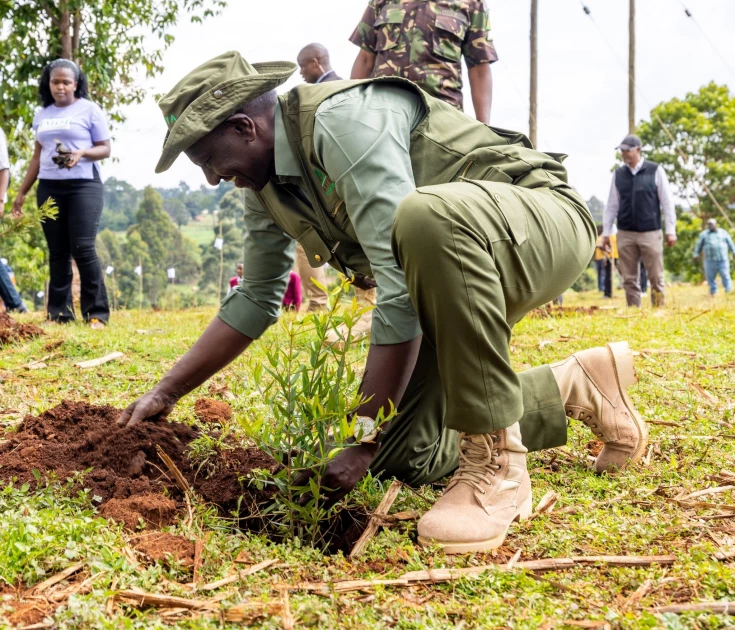Kenya seeks to plant 100 million trees on October 10th: Is Ruto's 15 billion target still on track?

President William Ruto leads a tree planting exercise at Kaptagat Forest on July 13, 2024. PHOTO| PCS

Audio By Vocalize
Recently, the government through the Forestry
Principal Secretary Gitonga Mugambi and his Environment counterpart, PS Festus Ng’eno, announced an ambitious plan to
grow at least 100 million trees on the October 10th public holiday,
now renamed Mazingira Day.
The government officials said that of the
100 million trees to be planted, at least 71 million tree seedlings will be
fruit seedlings, planted in schools nationally, with each school expected to
plant at least 2000 trees.
The high-placed public officials said
Mazingira Day, now dedicated to environmental conservation issues, will be an
opportunity to rally Kenyans to plant trees, clean up the environment and
embrace sustainable environmental practices. PS Mugambi said the deliberate
move to plant fruit trees is designed to fuse environmental restoration with
economic empowerment.
“Fruit trees are good for nutrition. In the
next two to three years, these trees will create jobs, wealth and protect the
environment,” he said.
Mugambi requested Kenyans from all walks of
life to visit their former primary schools, donate seedlings and take part in
clean-up exercises under the rallying call 'Turudi Primo: Tu-kadonate Fruit
Trees na Ku-clean Environment'.
This tree-planting drive on October 10th
will be one among several in the recent past, driven by the government to
achieve conservation efforts and achieve a 30 per cent tree cover by 2032.
Jaza-Miti Program launched by President
Ruto
In December 2022, the newly inaugurated Kenya
Kwanza government, led by President William Ruto, launched a novel program called
"jaza miti.” Its aim was to encourage Kenyans to plant at least 15 billion
trees by 2032.
The "Jaza Miti" program is a
Special Presidential Forestry and Rangeland Restoration Program. Considered by
many to be an overly ambitious goal, it seeks to counter the devastating
effects of climate change, such as unpredictable rainfall patterns, droughts, and
floods by planting more trees to mitigate extreme climate change. Later, President
Ruto, on his birthday, symbolically planted 56 trees to signify his years on
earth and to show how closely he regarded the cause.
In the recent past, President William Ruto claimed
Kenya had planted over 750 million trees in 2024 alone to indicate the
country’s greening ambition was on course. President Ruto hopes that by
reducing greenhouse emissions, curtailing deforestation and restoring over 5.1
million hectares of deforested land, restoration will be possible under the
auspices of the African Landscape Restoration Initiative, launched on 22nd December
2022. Little has been achieved, and they remain remarkable steps. This was
made possible through the collective effort by government ministries,
departments and agencies, Kenyans from all walks of life, various corporates,
small holder farmers, schools, and the private sector.
President Ruto kicks off national tree
planting campaign
On 10th May 2024, President Ruto led a nationwide tree-planting campaign in Kiambicho Forest in Maragùa, Murang’a
County. The President said the “tree planting day” was a Cabinet decision to
honour those who had perished as a result of heavy floods that had ravaged various
parts of the country in early 2024.
Planting and nurturing trees, he said, was
the solution to mitigate the harsh effects of climate change, such as droughts,
hunger and destructive floods. The president further stated that the government
had set a target of 200 million trees to be planted by Kenyans across the
country in 2024. The President announced that the tree-planting exercise would
continue until the close of the year.
The high cost of tree planting efforts,
at times, negates the spirit of conservation
On 13th November 2024, the
government announced a random tree planting holiday, and its top officials went
all out to plant trees towards achieving the ambitious 15 billion trees by
2032. In a breakaway from the normal flocking of all top officials where the
President is, Cabinet Secretaries and their Principal Secretaries were all
dispatched to different counties around the country to plant trees. It became
an expensive affair, as the same officials not only used big fuel-guzzling
vehicles to reach their destination, quite a number of them made use of helicopters
to reach far-flung areas and thereby beating the very reason for which they
came out to plant trees, all the while costing the taxpayer millions of
shillings.
At a time when public-sector austerity
measures were the byword in the country, including cutting costs on logistics
and travel for government officials, the choice of fuel guzzlers and choppers
for top government officials’ transport during the tree planting exercise beat
all logic. The intention of the tree-planting holiday was very noble but its
execution left many Kenyans appalled. However, the Government Spokesperson,
Isaac Mwaura, saw no harm in using expensive and environmentally harmful means
of transport; instead, he affirmed the exercise a “huge success” noting that the
government would continue with the initiative.
Kenya’s
fight to regrow its forest cover
Over the past decades, Kenya has had
numerous campaigns on tree planting and reforestation, such as the Million Operation
Gavisha of 1977, Trees Campaign of 2006, the Greening Kenya Initiative of 2010
and the Accelerated National Tree Growing Campaign of 2022.
Despite all these efforts, Kenya is still
in a race to attain a minimal tree and forest cover of at least 30 percent by
2032. Vision 2030, Kenya’s present economic blueprint, under the social
pillar, talks of providing all citizens with a clean, secure, and sustainable
environment by the year 2030. To achieve this, the State set goals such as
increasing forest cover from less than three per cent of its land base in 2007
to 10 per cent by 2030.
Losing
ground when there should be progress
According
to Global Forest Watch organisation, in 2020, Kenya had 2.72 million
hectares of natural forest, extending over 4.6% of its land area. From 2002 to 2024, Kenya
lost 54.1 thousand hectares, or 14% of its total tree cover in the
same time period. All this took place even as the government launched a
campaign to plant 15 billion trees in ten years from 2022 in a bid to reach 30%
tree cover by 2032, and not just the 10% envisioned under Vision 2030.
Tree
planting has emerged as a powerful sustainable solution to mitigate the adverse
effects of climate change and reduce environmental degradation. Planting trees
not only helps combat climate change by absorbing excessive carbon dioxide, but
it also provides a wide array of environmental, social, and economic benefits.
Forests act as “carbon sinks,” helping to reduce the concentration of
greenhouse gases in the atmosphere.
Constraints
towards achieving the desired tree cover in Kenya
One of the major challenges impeding the
achievement of the national strategy for 30% tree cover by 2032 is the lack of
implementation of the Special Presidential Forestry and Rangeland Restoration
Program popularly referred to as ‘Jaza Miti’, despite the strategy’s
adoption and approval by the Cabinet in December 2022.
The “Jaza
Miti” project is also impeded by the failure to recruit
a substantive senior staff in the state department to spearhead its strategy, into
the position of “Forest Conservation Secretary (FCS).” The FCS is a position under
the Principal Secretary and the office coordinates all forestry agencies in the
Ministry. The FCS also interacts with all other government ministries,
departments and agencies (MDAs) on issues concerning forestry in the country.
Is Kenya on course to achieve its lofty
30 billion trees by 2032?
Kenya's plan to plant 15 billion trees in
10 years, or planting 1.5 billion trees each year, is a tall order. This
translates to 125 million every month and 4 million trees each day. Since the project roll-out, Kenya has managed
to plant only 783 million trees by April 2025 under the National Tree Growing
Restoration Campaign.
On the other hand, resource allocation for
tree planting and management has been wanting. In 2022/23 financial year, only
Ksh.10.15 billion was allocated. In 2023/24 financial year, only Ksh.14.3
billion was allocated in the national budget for forest conservation and other
tasks. These amounts are way short of the projected Ksh.600 billion for the
ten-year campaign or at least Ksh.60 billion annually to achieve the 30% national
tree cover. Counties have also been allocating funds from their annual budgets for
forest conservation requirements but this too has remained a drop in the ocean.
To ordinary Kenyans, trees are essential in
creating a balanced environmental ecosystem. Trees, as a supply of energy are
almost next to water in order of importance to human life. Apart from providing
wood-fuel and charcoal for energy, trees also provide important goods such as
timber, not to mention fruit, fodder, medicines, gums and resin, all for human use.
The legal framework found in the Kenya
Forest Policy 2014, Forest Conservation, Land Act 2012, and Management Act
(2016) coupled with National Climate Change Response Strategy, are a
comprehensive ground on reforestation and the management of forests. The
Constitution of Kenya 2010 provides a good platform for counties to help manage
community lands.
However, as witnessed in Nairobi’s Karura
Forest and other forests, unchecked logging and poor forest management are
frustrating any meaningful gains and forests continue to shrink. The shrinkage
rate is estimated at 12,000 hectares of forested land annually, attributable to
increased wood fuel and charcoal demand, inadequate funds set aside for
conservation, population growth, expanding infrastructure, and forest
conversion for commercial agriculture.
To
get to the goal…
To achieve the 30% tree cover, the
government should include environmental education in school curricula as well
as utilize community outreach programs to nurture environmental stewardship in
communities. It should also engage in multi-lateral advocacy platforms to
achieve informed communities on environmental issues as a community’s
involvement assures sustainability.
Public authorities should strive to
allocate sufficient funding and resources to support the ongoing planting,
nurturing and management of forests including funding civic education
campaigns. It is possible that the government could make effective use of public-private
partnership to achieve this end as seen at Karura Forest, Nairobi. This fosters
collaboration, draws in the civil societies, community ownership, volunteerism
and free expertise on many fronts.

Leave a Comment